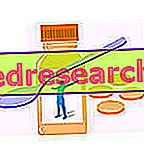Nails are defined as fragile when:
- They present various alterations of form and structure
- They become less elastic
- They break easily.

- With vertical streaks and cracks called onicoresses
- Uniforms, but which tend to unravel from the outer layers towards the deep ones; this condition is known as oncoschizia lamellina .
Women and the elderly are more frequently affected and, depending on the case, the problem may be temporary or persistent.
Brittle nails can have many causes and it is the doctor's job to identify which ones.
What to do
- In case of individual predisposition to nail fragility it is necessary to adopt an effective prevention (see under Prevention).
- When brittle nails appear, try to identify the cause. In the absence of other symptoms, it is possible to intervene without going to the doctor:
- Follow a balanced diet: fragile nails are often the result of general malnutrition. They appear frequently in the case of anorexia and in the third and fourth world population. It is advisable to pay more attention to the contents of:
- Vitamins: A (retinol and carotenoids), E (tocopherols), C (ascorbic acid), B6 (pyridoxine).
- Minerals: iron, zinc, selenium, copper, phosphorus and calcium.
- Limit physical trauma, chemical stress and exposure to allergens.
- Minimize non-prescribed drug therapies.
- On the contrary, in the presence of other symptoms, medical intervention may be essential. The diseases that cause nail fragility are metabolic, autoimmune, infectious, genetic and vascular:
- Onychomycosis: requires the use of antifungal drugs for topical use (see Onychomycosis Remedies).
- Lichen planus: it is an autoimmune disease that can arise after infection with viral diseases, exposure to allergenic molecules, the use of certain drugs and so on. It is treated with drugs.
- Psoriasis: is an idiopathic autoimmune disease. It is treated with drugs.
- Progeria: it is a genetic disease that cannot be cured. Some therapies are aimed at reducing complications.
- Turner syndrome: like the previous one.
- Thyroid dysfunction: especially hyperthyroidism. The treatment is represented by a hormonal therapy.
- Peripheral atheropathy and Raynaud's syndrome: impair peripheral blood circulation and reduce tissue oxygenation, in addition to the influx of useful molecules. The therapy is pharmacological or, in case of atherosclerosis, surgical.
What NOT to do
- Expose your nails to chemical stress: detergents, solvents, aggressive soaps etc.
- Expose your nails to repeated micro-traumas: usually posters during sports, hobbies and work.
- Expose the nails to allergenic molecules (dermatological reaction).
- Biting nails repeatedly.
- Smoking, especially in large quantities.
- Subject nails to very invasive, fraying and close-up manicure techniques.
- Follow an incomplete or insufficient diet.
- Do not cure or treat diseases responsible for nail fragility.
What to eat
The diet to combat fragile nails is a balanced dietary scheme; In short:
- Normal calorie intake: the energy must be sufficient to support all bodily functions and well fractionated between energy nutrients (25-30% lipids, 45-60% carbohydrates and the rest proteins).
- Coverage of essential and necessary requirements: they are nutrients that the body is unable to synthesize independently or without which it can withstand for a limited time: omega 3 and omega 6, essential fatty acids, vitamins and mineral salts, minimum fraction of carbohydrates .
- Pay more attention to the contribution of:
- Vitamin A: retinol or carotenoids. They are contained in offal, in cheeses, in animal fat, in shellfish, in vegetables and in orange fruit (apricots, peppers, melons, peaches, carrots, squash, tomatoes, etc.).
- Vitamin E: tocopherols or tocotrienols. They can be found in the lipid portion of many seeds and related oils: wheat germ, maize germ, sesame, kiwi, grape seeds, etc.
- Vitamin C: ascorbic acid. It is typical of fruit and some sour vegetables: lemons, oranges, mandarins, grapefruit, kiwi, peppers, parsley, chicory, lettuce, tomatoes, cabbage etc.
- Vitamin B6: pyridoxine. It is contained in: meats, offal, some fish, poorly refined cereals (especially in wheat germ), legumes and walnuts.
- Iron: especially heme and ferrous. It is contained in: offal, meat, fishery products (fish, molluscs) and egg yolk.
- Zinc and selenium: the first is contained mainly in liver, meat, milk and derivatives, some bivalve molluscs (especially oysters). The second is contained above all in: meat, fishery products, egg yolk, milk and dairy products, fortified foods (potatoes, etc.).
- Copper: it is mainly contained in liver, molluscs, chocolate and nuts.
- Phosphorus and calcium: typical of milk and derivatives. Calcium is also present in oilseeds and legumes. Phosphorus also abounds in fishery products.
What NOT to Eat
There are no foods less recommended than others. However, it is recommended to avoid:
- Monothematic diets.
- Vegan diet.
- Diet free of vegetables and vegetables.
- Diets based solely on:
- Cooked foods.
- Preserved foods.
- Furthermore, it is advisable to avoid alcohol abuse. It is potentially responsible for malabsorption and alteration of vitamin metabolism.
Natural Cures and Remedies
- Food supplements: are those containing the vitamins and minerals mentioned above. Particularly used are the supplements based on collagen, MSM (organic sulfur), cystine, calcium, silicon, zinc, copper and vitamin mix.
Pharmacological care
Pharmacological treatments for nail fragility concern the treatment of any primary diseases responsible. For example:
- Drugs for Lichen planus:
- Corticosteroids: for topical use in ointment or systemic tablets, they are able to reduce the associated inflammation. Potential side effects may limit its use for diabetics and other individuals suffering from metabolic disorders.
- Antihistamines: they act as anti-inflammatories.
- Retinoids: to be applied mainly on the spot in the form of ointment. They are synthetic versions of vitamin A that can promote skin regeneration.
- Drugs for onychomycosis:
- Enamels and ointments:
- Azole derivatives: ketoconazole eg Ketoconazole EG or miconazole eg Daktarin.
- Morpholinic derivatives: amorolfine in enamel, for example Locetar.
- Allylamines: naftifina, for example Suadian, indicated against dermatophytosis.
- Ciclopirox: enamel for example Fungizione.
- Polienici: nystatin-based creams, such as Assocort, Mycostatin.
- Tolnaftati: selective against Trichophyton and Epidermophyton.
- Systemic antifungal drugs for oral use:
- Tablets:
- Azole derivatives:
- Imidazole, for example miconazole as Oravig.
- Triazole, for example itraconazole like Sporanox.
- Griseofulvin, for example Fulcin.
- Azole derivatives:
- Drugs for thyroid dysfunction: hormone replacement therapy.
- Psoriasis drugs (for topical and oral use): emollients, vitamin A, vitamin D, mineral tar, corticosteroids, salicylic acid, biological drugs, immunosuppressants, etc.
Prevention
- Eat properly.
- Avoid repeated microtraumas.
- Limit nail exposure to corrosive chemicals.
- Eliminate contact with allergens.
- Do not abuse drugs.
- Do not bite your nails repeatedly.
- Stop smoking.
- Avoid repeated and aggressive manicure techniques.
- Neglecting diseases responsible for nail fragility.
Medical Treatments
There are no medical treatments aimed at treating brittle nails, except for those intended for primary diseases.



